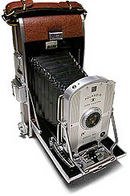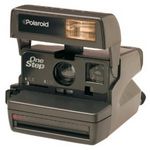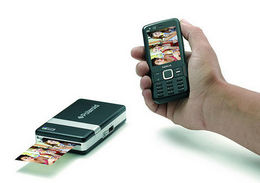Polaroid Camera
Contents
Early Years
Dr. Edwin Land (a physicist) came to the forefront of photographic technology in 1929 when he created the first synthetic sheet polarizer; thus solving "one of science’s long-standing 'unsolvable' problems – polarizing light without needing a large crystal of an esoteric mineral" (Save Polaroid). This technology enabled not only the development of the Polaroid camera but sunglasses, 3-D glasses, glare-reducing glass and windows, and many other products as well. Then, in 1937, Dr. Land founded the Polaroid Corporation. However, the idea of an instant camera (and subsequently instant photography) wasn’t envisioned by Dr. Land until 1943 in response to his 3-year-old daughter’s confusion as to why a camera could not instantly produce pictures. According to the story that has sprung up around the invention of the instant camera, Land's daughter asked her father (who was taking family pictures), “Why can’t I see them now?” (Pace). The question intrigued Dr. Land and set him on the quest to solve the problem of instant photograhpy.
Dr. Land was responsible for overseeing the development of products for the Polaroid Corporation – including the first instant camera. In 1947 the concept of instant photography was presented to The Optical Society in New York City and shortly after, in 1948, instant photography became available to the public with the introduction of the Polaroid Model 95 Camera (also referred to as the Polaroid Land Camera) and Type 40 film. The Polaroid Land Camera was welcomed and widely accepted by consumer markets – even with a $95 price-tag (approximately $850 today) the camera flew off shelves and sold out in a matter of weeks. The demand for the new camera was so great that backorders began being taken and consumers started to pay up to $150 (approximately $1350 today) for the new instant photography device (Save Polaroid).
A long line of instant photography developments and products proceeded the Polaroid Land Camera’s release and by the 1960’s approximately fifty-percent of American households owned a Polaroid camera (Pace).
VIDEO - Invention: The First Polaroid Camera (Discovery Channel)
What Makes Instant Film Different
How to Take a Picture
Polaroid Film Camera
Step 1 Purchase the Polaroid film specified for use with your Polaroid camera model.
Step 2 Load film into your Polaroid camera (instructions vary depending on the Polaroid camera model.
Step 3 Although the Polaroid camera automatically adjusts focus, getting closer than 18 inches from the subject will cause the photograph to blur.
Step 4 Choose the exposure control feature you want in order to customize your image quality - a longer exposure time is best for use in areas with low light while a shorter exposure time is best for use in areas with bright light.
Step 5 If your Polaroid camera has extra features (i.e., a self-timer) you should adjust these settings to your preference now.
Step 6 Take your picture - your photograph will be produced in under 60 seconds (eHow).
Applications
The introduction of the Polaroid instant camera created a sensation among regular camera users. The obvious immediate application for “instant pictures” was at family gatherings (i.e., birthdays, holidays, etc.) since it allowed people to see the photos right away and, if necessary, reshoot the picture. But an entire market emerged for other applications as well. For example, many professions and services benefitted from the ability to create near “instant” photographs – DMV’s, Post Offices, and other institutions (business, schools, etc.) used them to quickly snap photos for driver’s licenses, passports, and ID cards.
Doctor’s and hospitals began using them to document visible injuries their patients may have had and some even began to use them for “before and after” reference (this was particularly common in dermatology). However, the Polaroid camera was most commonly used in the medical field to take pictures of ultrasounds (in order to provide parents-to-be with their own photograph copy).
Law enforcement was another professional that took advantage of the Polaroid camera’s ability to take instant photos – often police officers and crime scene investigators used Polaroid Cameras because of their ability to create immediate, unalterable, photographs (crucial in mug-shots or the documentation of evidence from a homicide).
Noteworthy Dates (and Information) on Several Polaroid Models
1948: The first Polaroid Land Camera, a Model 95, is sold at Boston’s Jordan Marsh department store.
1964: The five-millionth Polaroid Land Camera, an Automatic 100, is manufactured.
1971: The Big Shot Land Camera, designed to take flash color portraits, debuts.
1972: The SX-70 system is introduced. The camera is fully automatic, motorized, folding, single-lens reflex which ejects self developing, self-timing color prints.
1976: Sales of Polaroid cameras exceed six million units.
1977: The OneStep Land Camera is the best-selling camera in the U.S. for more than four years. This year Polaroid sales exceed $1 billion.
1986: The Spectra debuts at Jordan Marsh in Boston.
1998: The OneStep is the world’s best-selling camera.
1999: 9.7 million instant cameras are sold. The iZone Pocket Camera and "sticker" film are introduced.
2004: Polaroid introduces a new line of six instant cameras (Naples Daily News).
Decline
Kodak Lawsuit
On October 6, 1981, in a court battle over the invention of the instant camera, the Polaroid Corporation accused the Eastman Kodak Company of "violating its patents in a way that 'strikes at the very heart of Polaroid's business'" (The New York Times). Polaroid claimed that Kodak illegally copied their technology and "entered Polaroid's exclusive field" with their 1976 introduction of an "instant color camera" (The New York Times). Polaroid's lawyer, William K. Kerr stated that "'Kodak unsuccessfully tried to develop non-infringing methods...[b]ut they bumped against stone walls and eventually were driven to infringe upon Polaroid's patents.' This patent infringement, he said, 'strikes at the very heart of Polaroid's business,' whereas instant photography represents 'only a very small part of Kodak's overall business'" (The New York Times).
In 1985 Kodak was found guilty of infringing seven of Polaroid's instant photography patents and was forced to stop producing devices that allowed for instant photography. However, the question of how much economic damage Polaroid had suffered was still unanswered (Holusha). The Polaroid Corporation claimed that Kodak's development and production of instant photography devices and products caused Polaroid to lose $4 billion in profits. And, in a further claim that Kodak "willfully stole its technology," Polaroid asked to receive damages of $12 billion (Holusha).
On October 12 1990, "in the largest award ever in a patent-infringement case, a Federal judge ruled...that the Eastman Kodak Company must pay the Polaroid Corporation $909.4 million for infringing Polaroid's patents for instant photography" (Holusha). Unfortunately for Polaroid, "the decision represents something of a victory for Kodak, since it is well below the $12 billion sought by Polaroid and the $1.5 to $2 billion that some financial analysts had expected" (Holusha).
Marketing
"There was a time when there was nothing to beat a Polaroid camera for instant gratification. But in a world of disposable cameras, one-hour film processing and the camcorder, Polaroid's...sales [suffered]" (Smith).
Although Polaroid began to see a drop in sales during the late-1990's some argued that it wasn't due to new progressive technology but rather due to poor marketing. Some claimed that the company was simply marketing it in the same category as "documentary" or "recording" devices when it should have been marketed as a "social enhancement device." For example, Martin Smith, BBH's deputy chairman, is cited as saying that "Polaroid operate[d] in a different market from 35mm cameras and advanced photography systems. Rather than recording the event, it add[ed] to it, and help[ed] it to become more informal. It [was] less about memories [and] more like alcohol and karaoke" (Smith).
However, even with a marketing move away from traditional camera outlets and toward buying a Polaroid camera to enhance social occasions (such as making the cameras available at bars and clubs) sales continued to decline.
Digital Photography
With the creation of digital photography, and the increasing popularity of photo viewing and sharing via the computer and Internet, most of Polaroid's consumer base has left the instant camera behind for the digital camera. Even business applications that so popularly used the Polaroid camera have now switched (or are in the process of switching) to the digital camera. For example, almost all Post Offices, DMV's and other institutions are now using digital cameras to take photographs for passports, driver's licenses and ID cards. Even professional photographers who often used the Polaroid camera to preview lighting before taking an expensive photograph are switching to digital cameras - this is because the digital camera not only provides an instant visual of the photo (via a screen on the back of the camera) but also allows almost near instant access to a large, high-def, visual of the image if attached to a computer. Furthermore, digital cameras don't waste film in previewing photographs since everything is viewed on a screen - this cuts down on costs.
Bankruptcy
On October 12, 2001 the Polaroid Corporation filed for Chapter 11 bankruptcy protection. “The news did not shock Wall Street, where analysts…watched the company's stock sink and debts soar as digital cameras hurt Polaroid's core instant photography business…Its stock, which approached $50 in early 1998, was selling for 28 cents...In its filing, the company listed $1.81 billion in assets and $948.4 million in debts” (Deutsch).
The Polaroid instant camera was the basis for founding the Polaroid Corporation and drove the company’s profits for decades. Unfortunately, it was Polaroid’s large reliance on the instant camera – “a vicious cycle of constantly putting all the eggs in one basket” – that ultimately led to the company’s financial failure (Deutsch).
In 2005 Polaroid was bought by Peters Group Worldwide (a private investment company) for approximately $426 million (Naples Daily News).
Cell Phones and Computers
The popularity of viewing images on screens didn't just impact how consumers were previewing and sharing images but also how they were storing and saving images. Over the past several years it has become more and more common (especially among younger generations) to not keep a hard copy of photographs. The days of photo albums and prints are disappearing and being replaced by online photo-sharing websites such as Facebook and Webshots, camera-phones, and iPhoto. Many consumers find that higher definition images, the ability to edit, and the ability to instantly share (either via email, a website, or cellphone) a photograph, with a near infinite number of people, is far superior to a small, unalterable, physical copy.
Death
It’s ironic that the death of the Polaroid instant camera resulted from the device’s inability to be “instant” enough. “But in a day when nearly every cellphone has a digital camera in it, ‘instant’ photography long ago stopped being instant enough for most people” (Lyons).
The Polaroid Company, which ceased their production of instant cameras for consumers a in 2007 and for commercial use in 2006, announced in 2008 that it would cease to produce and manufacture instant film in 2009.
However, the Polaroid Company is allowing their technology to be licensed to other manufacturers after 2009 – should they want to provide the film to the niche market that will continue to use the Polaroid camera (Lyons). Furthermore, there has been confirmation that at least three of the peel-apart pack films will be reintroduced in 2009 (Zink).
Future
When the first Polaroid camera was introduced in 1948 millions of individuals were, all of a sudden, able to quickly snap photographs and enjoy them instantly – instead of waiting several days, or longer, for them to be developed.
Today, Polaroid is once again leading the way for improvements in the “instantaneity” of photography – this time with photos taken by digital cameras and camera phones.
During the third quarter of 2008 the Polaroid Corporation partnered with Zink to create and market the Polaroid PoGo Instant Mobile Printer – a small, portable, battery-powered printer from the company that was built on Edwin Land's Polaroid (Eisenberg).
“Polaroid PoGo™ - short for Polaroid-on-the-go - is a pocket-sized, ink-free digital photo printer that produces full-color photos wirelessly from Bluetooth-enabled cell phones and via PictBridge from digital cameras. Weighing only eight ounces, Polaroid PoGo™ provides consumers with a convenient solution for sharing digital images trapped on cell phones and digital cameras. Connecting via Bluetooth or PictBridge, Polaroid PoGo™ uses a revolutionary ZINK Zero Ink Zero Hassles™ Printing Technology to produce borderless, full-color, 2-inch by 3-inch prints in less than 60 seconds” (ZINK).
The Polaroid PoGo printer connects to cell phones wirelessly via Bluetooth technology and to digital cameras via a cable. The Printer, when first released, cost $150 but as of October 2008 can be purchased (from some sellers) for just under $100. The images produced by the PoGo are 2 inches by 3 inches.
The PoGo is unique in that it doesn’t use cartridges or toner (because it doesn’t use ink). “Instead, there is a computer chip, a 2-inch-long thermal printhead and a novel kind of paper embedded with microscopic layers of dye crystals that can create a multitude of colors when heated” (Eisenberg).
“When the image file is beamed from the camera to the printer, a program translates pixel information into heat information. Then, as the paper passes under the printhead, the heat activates the colors within the paper and forms crisp images” (Eisenberg).
The unique paper was created by former Polaroid employees and conceptualized at Polaroid. However, after Polaroid filed bankruptcy in 2001 (and was later sold to the Petters Group) the employees founded the company ZINK Imaging in 2005 where the product was able to be developed and made available to buyers (Eisenberg).
Does the Market Exist?
Although the PoGo Printer may appeal to some consumer markets (i.e., teenagers who decorate with photos, or for use during special occasions), it appears to be having a problem finding a niche - it's been available to the public for less than six months and already most retailers have drastically reduced the price of the PoGo (on an average of 33%).
As we live in an increasingly digital age, the need for things to be instant is in high demand. We are moving away from physical artifacts (i.e., a printed photographs) that are restricting, limiting, and increasingly less important and towards digital artifacts (i.e., digital photographs) that can be shared and stored more effectively and efficiently.
Although some physical artifacts such as driver's licenses and passports will likely continue to stay as physical entities, these artifacts are not intended to be replicated or shared - unlike personal photographs.The problem with the PoGo, and all other devices that focus on producing physical copies of photographs, is that only a fraction of images taken on a camera ever end up being printed. The ability to share photos more "instantly" than physical prints through digital technology (paired with email, cellphones, websites, etc.) greatly limits the demand for devices that only produce physical prints. It seems that, with the release of the PoGo, Polaroid is making the mistake of trying to tap a market that doesn't exist.
Works Cited
Amazon. Image: Polaroid OneStep Camera. Amazon. 25 Oct. 2008. <http://www.amazon.com/Polaroid-One-Step-600-Instant-Camera/dp/B00004RFC5>.
Deutsch, Claudia H. "Deep in Dept Since 1988, Polaroid Files for Bankruptcy." The New York Times. 13 Oct. 2001. <http://query.nytimes.com/gst/fullpage.html?res=9A00E0D8123FF930A25753C1A9679C8B63&n=Top/Reference/Times%20Topics/Subjects/C/Credit>.
Discovery Channel. Video: Invention: The First Polaroid Camera. Discovery Channel. 25 Oct. 2008 <http://videos.howstuffworks.com/discovery/29594-invention-the-first-polaroid-camera-video.htm>.
eHow. "How to Use a Polaroid Camera." eHow. 26 Oct. 2008. <http://www.ehow.com/how_2075800_use-polaroid-camera.html>.
Eisenberg, Anne. Image: Edwin Land, Founder of Polaroid. The New York Times. 13 April 2008. <http://www.nytimes.com/2008/04/13/technology/13novel.html?scp=30&sq=polaroid%20camera&st=cse>.
Eisenberg, Anne. “Instant Digital Prints (and Polaroid Nostalgia).” The New York Times. 13 April 2008. <http://www.nytimes.com/2008/04/13/technology/13novel.html?scp=30&sq=polaroid%20camera&st=cse>.
Holusha, John. “Kodak Told It Must Pay $909 Million.” The New York Times. 13 Oct.1990. <http://query.nytimes.com/gst/fullpage.html?res=9C0CE6D91F39F930A25753C1A966958260&sec=&spon=&&scp=4&sq=polaroid%20kodak%2suit&st=cse>.
HowStuffWorks. "How Instant Film Works" HowStuffWorks. 26 Oct. 2008. <http://science.howstuffworks.com/instant-film.htm>.
HowStuffWorks. Image: Instant Camera Film. HowStuffWorks. 25 Oct. 2008. <http://www.howstuffworks.com/question605.htm>.
Lyons, Patrick J. “Polaroid Abandons Instant Photography.” The New York Times. 8 Feb. 2008. <http://thelede.blogs.nytimes.com/2008/02/08/polaroid-abandons-instant-photography/?hp>.
Naples Daily News. "The Polaroid Project: The Timeline." Naples Daily News. 20 April 2008. <http://www.naplesnews.com/news/2008/Apr/20/polaroid-project-timeline/>.
Pace, Eric. “Edwin H. Land Is Dead at 81; Inventor of Polaroid Camera.” The New York Times. March 2 1991. <http://query.nytimes.com/gst/fullpage.html?res=9D0CE6D8133AF931A35750C0A967958260>.
Polaroid. Image: Zink Enabled Polaroid PoGo. 25 Oct. 2008. <http://www.polaroid.com/us/index.jsp?co=usbmLocale=en_US>.
Save Polaroid. “A History of Polaroid.” Save Polaroid. 23 Oct. 2008. <http://www.savepolaroid.com/history>.
Save Polaroid. Image: Edwin Land and the First Synthetic Sheet Polarizer. Save Polaroid. 23 Oct. 2008. <http://www.savepolaroid.com/history>.
Save Polaroid. Image: Polaroid Model 95 Camera. Save Polaroid. 23 Oct. 2008. <http://www.savepolaroid.com/history>.
Smith, Allison. “Having a Party with Your Polaroid Camera – Marketing Brand Management.” F.T. Business Enterprises Limited. 26 May 1998. ProQuest. NYU. 20 Oct. 2008. <http://proquest.umi.com/pqdlink?did=29683432&Fmt=7&clientId=9148&RQT=309&VName=PQD>.
The New York Times. “Polaroid Says Kodak’s Entry In to Instant Photos Injured It.” The New York Times. 6 Oct. 1981. <http://query.nytimes.com/gst/fullpage.html?res=9F03E5DF1239F935A35753C1A967948260&scp=9&sq=instant20camera%20polaroid&st=cse>.
ZINK (Zero Ink). Image: PoGo and Bluetooth Technology. ZINK. 22 Oct. 2008. <http://www.zink.com/partner-products>.
ZINK (Zero Ink). “Partner Products.” ZINK. 22 Oct. 2008. <http://www.zink.com/partner-products>.



